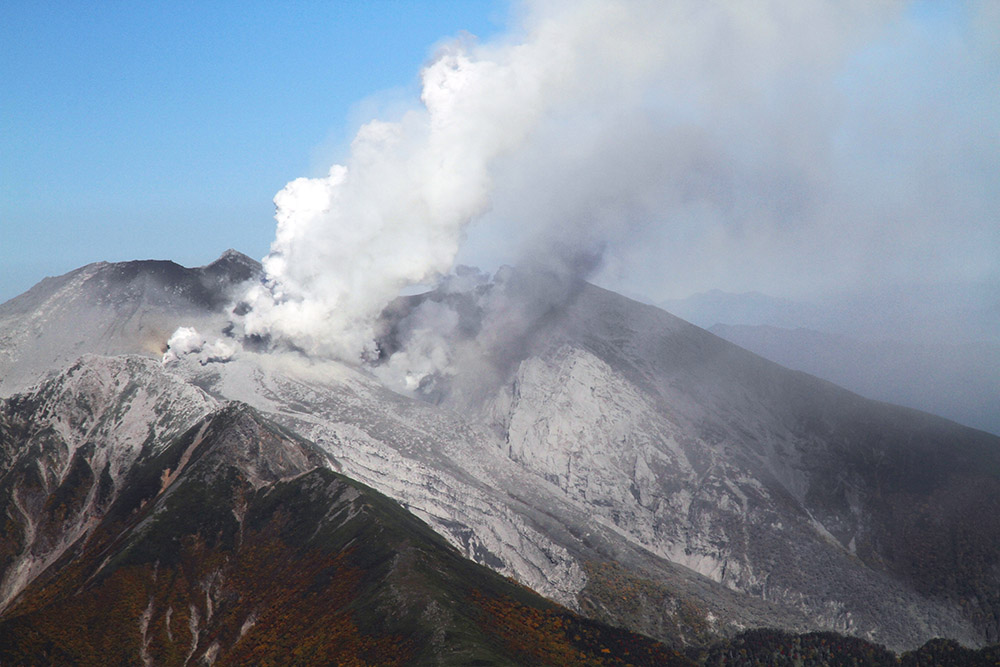Bulletin of the Geological Survey of Japan Top Page
Bulletin of the Geological Survey of Japan Vol.65 No.9/10 (2014)
Cover photograph | Table of Contents | Abstract
Cover photograph
Eruption of Ontake Volcano in September, 2014
Aerial view of Jigokudani Craters as seen from the SW (the day after the phreatic eruption). Craters are formed along the line of the NW-SE direction and smokes from the rightmost crater are grayish, including volcanic ash. The highest peak in the background is Kengamine (3,067m a.s.l.). The "low-temperature" pyroclastic flow generated at the early stage of the eruption and deposited in the grayish area in the foreground. Photo by S. Nakano, at 16:04, September 28, 2014 by cooperation of The Yomiuri Shimbun.
(Photograph and Caption by Shun Nakano)
Table of Contents
All the pages PDF : 65_09_full.pdf [7MB]
| Title | Author | |
|---|---|---|
| Reports | ||
| Higher terrace deposits along the Katakami River,central Mie Prefecture, southwest Japan |
Takeyuki Ueki
(p105-111) |
65_09_01.pdf [950KB] |
| Radiometric age of a newly recognized Quaternary volcano: Naramata caldera, NE Japan |
Takahiro Yamamoto
(p113-116) |
65_09_02.pdf [1.4MB] |
| The pyroclastic density currents generated by the September 27, 2014 phreatic eruption of Ontake Volcano, Japan |
Takahiro Yamamoto
(p117-127) |
65_09_03.pdf [9.3MB] |
Abstract
Higher terrace deposits along the Katakami River,central Mie Prefecture, southwest Japan
Takeyuki Ueki
The Higher terrace deposits are distributed along the Katakami River of 4 km long, central Mie Prefecture, southwest Japan. The deposits are composed of angular to subangular clasts of sandstone and show normal paleomagnetic polarity. The age pf higher terrace deposits along the Katakami River is estimated to be before Middle Pleistocene. Possible cause of the deposition of the coarse sediments to form the higher terrace is rapid sediment supply from deep-seated slope failure.
Radiometric age of a newly recognized Quaternary volcano: Naramata caldera, NE Japan
Takahiro Yamamoto
In 2009, it was decided to make the Quaternary with its base at approximately 2.6 million years ago. Corresponding to this revision, Geological Survey of Japan, AIST has published VOLCANOES OF JAPAN (third edition), including Gelasian volcanoes (Nakano et al., 2013). Naramata caldera, which is located in the northeastern part of the Gunma Prefecture, NE Japan, is one of such volcanoes. This caldera is made up of rhyolitic pyroclastics and overlying lacustrine sediments filling a depression 2 km in diameter. Fission-track age of zircons from rhyolitic pyroclastics was determined as 2.1 ± 0.2 Ma.
The pyroclastic density currents generated by the September 27, 2014 phreatic eruption of Ontake Volcano, Japan
Takahiro Yamamoto
A phreatic eruption occurred on September 27, 2014 at Ontake Volcano, and was accompanied with pyroclastic density currents. This currents shot by the Chubu Regional Development Bureau's camera at Takigoshi had the following characteristics. 1) Pyroclastic density currents occurred in two places (Jigokudani and western-flank) at the beginning of phreatic eruption. 2) The eruption column collapse height of the pyroclastic density currents did not exceed 300 m above the vents. 3) The front of the pyroclastic density currents traveling down the southern valleys moved at a speed of 8 to 20 m/s and reached 2 km from the vents. 4) Conspicuous secondary plume was observed rising from the current to ca. 2 km above the valleys; this suggests that the density currents possessed sufficient heat for the ash cloud to have risen due to its buoyancy. 5) However, no charring of trees was observed by helicopter observations. The Heim coefficient for the energy cone slope for the density currents is 0.45 to 0.55, when the column collapse height is 200 m.
Geological Survey of Japan, AIST
- About GSJ
- Our Activities
- Purchase guide
-
Publications and Database
- information
- Bulletin of the Geological Survey of Japan
- bull2025(Vol.76)
- bull2024(Vol.75)
- bull2023(Vol.74)
- bull2022(Vol.73)
- bull2021(Vol.72)
- bull2020(Vol.71)
- bull2019(Vol.70)
- bull2018(Vol.69)
- bull2017(Vol.68)
- bull2016(Vol.67)
- bull2015(Vol.66)
- bull2014(Vol.65)
- bull2013(Vol.64)
- bull2012(Vol.63)
- bull2011(Vol.62)
- bull2010(Vol.61)
- bull2009(Vol.60)
- bull2008(Vol.59)
- bull2007(Vol.58)
- bull2006(Vol.57)
- bull2005(Vol.56)
- bull2004(Vol.55)
- bull2003(Vol.54)
- bull2002(Vol.53)
- bull2001(Vol.52)
- Bulletin of the Geological Survey of Japan(old)
- Annual Report on Active Fault and Paleoearthquake Researches
- Reports, Geological Survey of Japan
- CCOP-GSJ Groundwater Project Report
- CCOP Technical Bulletin
- Cruise Report
- Geological Hazards
- Learning and Education
- GSJ Database Collection
- Collection of links


